Network Topology : Types, Advantages, Disadvantages & Its Applications
In computer networking, the performance of the network is determined by the type of configuration or topology. In network topology, the term topology is obtained from the two Greek terms like topo and logy, where ‘topo’ is ‘place’ and ‘logy’ is ‘study’.
A topology explains the structure of the network and shows how all the devices are connected logically and physically to interact or communicate with one another using communication or transmission links. The topology in a computer network is divided into two types such as physical topology and logical topology. This article gives a brief description of network topology and its types.
Mục Lục
What is Network Topology?
Definition: A network topology is defined as the structure of the network that is both physically and logically interconnected with one another and describes how the data is transferred between the nodes via communication links. A network might have various logical topologies and a single physical topology for simultaneous data transmission and communication. In simple words, it is a geometric representation of all the nodes, devices, and connections arranged on the network.
It is also referred to as the logical layout or physical layout of the network. A node is a computer network that might be a printer or computer or any other network device, which is capable of transmitting and receiving the data generated by other network devices.
The network topology describes how all the communication links, mapping of all the network components and nodes are arranged to communicate with each other. The network topologies in computer networks are of two categories like physical and logical.
Physical Type
This type of topology in computer networks explains how all the nodes or computers are connected for data transmission. In other words, it is the physical layout of the workstations, cables, links, and nodes in the network. It includes connections of several network elements like nodes, links, etc, location of the device, and installation of code of a network.
It also refers to the transmission medium of the signal. Examples – Bus topology, Star topology, Ring topology, Tree topology, Mesh Topology, Point-to-Point topology, and Hybrid Topology
Logical Type
This type of topology in computer networks shows how the data is transferred from one node/computer to another node/computer and is independent of physically connected network devices. The path of data transfer and the moment of data throughout the network depends on the network protocol. It refers to the internal communication of network devices with each other. Examples Twisted Pair Ethernet
Topology in Computer Network
The topology in a computer network is defined as, how all the nodes or computers and the network devices are connected and arranged on the network for data transfer from one to another. The network layout, which is either physical or logical, is directly related to the functionality of the network.
Choosing the right network topology for an organization or a company improves the performance and data transfer efficiency, optimization of allocated network resources, and reduces maintenance and operational costs.
A software-based network topology is important for diagnosing connectivity issues, detecting network downtime, and troubleshooting faults. The type of topology in a computer network chosen in the network depends on the application, equipment, rate of transfer of data, cost, and response time.
Types of Network Topology
The network topology is the schematic representation of all the connected nodes and the arrangement of the network through the various communication links. The network topology in a computer network is classified into 2 types such as physical network and logical topology.
The physical type is the physical layout of the network with all the connected nodes and peripherals. While logical type describes how the data is transferred between the connected nodes on the network.
The network topology in computer networks is categorized into 6 types based on the degree of security and connectivity, which comes under physical topology. They are,
- Bus Network Topology
- Star Network Topology
- Ring Network Topology
- Tree Network Topology
- Mesh Network Topology
- Point-to-Point Network Topology
- Hybrid Network Topology
- Multi-access Network Topology
- Smart Grid Network Topology
- Edge Computing Network Topology
Bus Network Topology
In this type, the network devices, and nodes/computers are connected to the single transmission line sequentially. It is also known as linear bus ]or backbone. It is very easy to install, cost-effective, but there is a chance of network failure or faults due to the single backbone or transmission line.
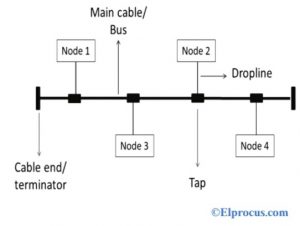
Working
When all the nodes or computers and network peripherals are connected to a single bus for communication then it is referred to as bus network topology. Here the bus works as a backbone cable for the entire network that connects every node and network device in the network.
The common bus contains several droplines and taps. Where droplines are communication cables and taps are connectors. These connect the bus cable with the node. The data communication between all the nodes is through only a single transmission channel.
The design of the bus type is illustrated in the figure below. To transmit the data from one node to another node in a single direction, one of the nodes works as a server. As soon as the data reaches the destination node or end, the data from the bus is removed by the terminator.
The transferred data along the bus cable flows through every connected node. The node scans the destination address to know whether it is equivalent to their address or not. When the address of the node matches with the address of the data, then it accepts the data for the process, or else it ignores it.
The network card type used in the computer decides the type of backbone cable to be used. Usually, RJ-45 connectors and coaxial cables are used to connect the nodes. Each connected in the bus network topology communicates independently with another node on the network.
Example: Ethernet cable.
The features of bus network topology are given below.
- The data is transferred only in a single direction
- If it contains only two endpoints, then it is referred to as a linear bus.
- If it contains more than two endpoints, then it is referred to as distributed bus network
- It provides a single connection between the nodes and the communication channel.
- It is reliable, flexible, and expandable with an average performance.
Star Network Topology
In this type of network configuration, all the network devices and nodes are fed to the central controller or central node called hub or switch or repeater via cables. If any failure occurs in any individual node or device or cable, then there might be a chance of failure of a central node. The fault in individual nodes doesn’t affect the other nodes or doesn’t create network downtime. This type of topology is most widely used and very popular among all other topologies.
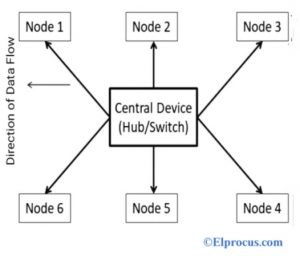
Working
When all the nodes/computers and network devices are connected to a central hub, then it is formed as star network topology. The central hub or switch acts as a central controller or central node between the connected nodes. If any one of the connected nodes wants to transfer the data to another node in the topology, first it should transfer the data to the hub and then the central hub sends the data to that specified nodes
The central node or central hub or switch provides the point-to-point communication link between the nodes. So, the other nodes (from another network) cannot access these nodes. The broadcasting of data or messages depends on the type of central hub used. If the switch is used as a central node, then it unicasts the data with the help of a switch table. If a hub is used, then it broadcasts the data. The data traffic on the network might increase if the broadcasting increases.
In a star type, the central hub and switch act as a server while the nodes and other network peripherals act as clients. It contains one input and one output port with one cable that is required to connect the node and the central hub. It uses RJ-45 cables or coaxial cables for connections.
It is also referred to as physical star type due to the use of hubs and switches. It provides higher security than other topologies because the data doesn’t flow through all the nodes. This type of topology is used in High-Speed Local Area Networks (LANs). The following diagram illustrates the star network topology.
The features of star network topology in a computer network are
- Every node that is connected to the central hub has its own dedicated link.
- To transfer the data between the connected nodes, the central hub acts as a repeater.
- It uses optical fibers, Coaxial cables, or twisted pairs for installation.
Ring Network Topology
In this type of topology, all the network devices and computers are connected sequentially to a backbone or transmission line by forming a ring. It is similar to the bus network topology except that the backbone ends at the starting node. That means each node or computer is connected to another node or computer, and the last node is connected to the first node to form a ring. It uses more repeaters and the mode of transmission is unidirectional.
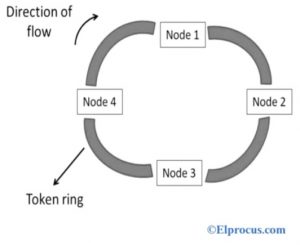
Working
When each node or computer is connected to another node in the network by forming a ring, then it is referred to as ring type. To form a ring network, the last network node is connected to the first network node. Hence the data flow would be unidirectional and circular. The structure of the ring network topology is illustrated in the figure below.
The ring-type in computer networks is in deterministic nature because each node will have access for data transmission at a predetermined time interval. The whole network working is based on the token system. As all the nodes are connected in a closed-loop, the token moves in one particular direction in a closed-loop.
In this type, when the token is free and moves around the network, the node captures the token and adds the data and destination address to it, and then leaves it for communication. When the token reaches the destination, the receiver removes the attached data and address, and then it is made free to carry and transfer the next data.
Example: Token ring.
The features of ring network topology in a computer network are given below.
The no. of repeaters required for this network topology is more with multiple no. of nodes. For example, consider the ring topology with 100 nodes. To transfer the data to the last or 100th node, then the data should flow through all the 99 nodes and then finally reach the 100th node. To prevent the loss of data during this process multiple repeaters are required in the network.
The mode of data transmission is unidirectional. By creating the two connections between the nodes in the network, it can be made bidirectional. This is called a dual-ring network topology
- In dual-ring type, the data movement between the two ring networks is in the opposite direction. If one ring fails, then the other ring acts as a backup to avoid network downtime.
- It provides sequential data transfer (bit by bit). The transmitted data should move through all the nodes in the network till it reaches the destination node.
Tree Network Topology
This type of network topology contains a root node with all other nodes connected to it hierarchically. It is also called the hierarchy type. All the nodes and devices are connected indirectly or directly to the main cable. It is mostly used in WAN ( Wide Area Network). It is a combination of star and bus network topologies.
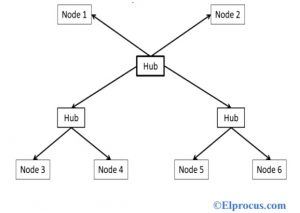
Working
When all the nodes are connected directly or indirectly to the main bus cable hierarchically, then that configuration is called tree network topology. It is an extended version of star and bus network topologies. The arrangement of nodes using tree network topology is shown in the figure below.
It contains a root node, which is the top node and all other nodes are sub-node connected hierarchically. There exists only one path or route for the transmission of data between any two nodes. In this type, the entire network can be divided into groups with the help of the main hub and sub-hubs connected to nodes to maintain and manage easily. If the bus cable or backbone cable fails, then the entire network gets crashed.
In tree network topology, one central hub is used to allow more nodes to be connected. But it takes more time to transfer the data by the central hub to all other nodes because of the increase in distance between them. It is more costly because it requires more cabling. If any fault occurs in the central hub or it fails, then the whole network might break down. It isolates and prioritizes the network from different nodes.
For example, corporate companies use the tree network topology to organize their data from the computers.
The following are the features of the tree network topology,
- If workstations are connected in groups, then the tree topology will be ideal.
- Used in WANs (Wide Area Networks)
- It provides a multi-point connection for data transfer between the nodes.
- It is a non-robust network topology.
- More flexible and scalable.
Mesh Network Topology
In this type, all the nodes or computers are interconnected with each other for direct communication between them in the computer network. It consists of n(n-1) /2 physical channels to link ‘n’ network devices or nodes. There are two types of mesh topologies. They are full mesh topology and partial mesh topology. To transmit the data over this network configuration, the two techniques are followed such as routing and flooding.
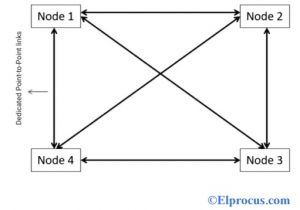
Working
The mesh network topology in computer networks is the interconnection of all the nodes/computers, and network devices with each other via dedicated communication links. It provides direct communication between the nodes in the network. The configuration of the mesh network topology is divided into two types. They are,
Full Mesh Topology
In this type, each node is connected to every other node in the network. There will be a point-to-point connection between every node in the network through a dedicated communication link. When there is an ‘n’ number of nodes in the network, then each node contains ‘(n-1)’ communication links and input-output ports.
Partial Mesh Topology
In this type, particular nodes are connected to every node in the network for frequent communication between them.
There are two types of communication links used in this network topology: simplex links and duplex links. In the simplex link, the data is transferred only in one direction. while in duplex links, the simultaneous data flow will be in both directions. The two simplex links can be replaced with one duplex link.
If the simplex link is used, then it requires ‘n(n-1)’ communication links for ‘n’ network devices. If the duplex link is used in the mesh topology, then ‘n(n-1) /2’ communication links are required. The diagram shown below explains the mesh type.
Example: The Internet or WAN
When the data is transmitted to the destination using the routing logic, then it is called routing in mesh network topology. The routing logic is used to decide the shortest path to direct the data towards the destination node. It contains information about failed communication links and nodes on the network.
When the data is transmitted through all the nodes connected to the network without using any routing logic, then it is called the flooding in mesh type. The network overload might occur due to the unwanted data in the network.
The features of mesh network topology are
- Fully connected with nodes and network devices,
- Robust in configuration
- Not flexible
- Widely used in wireless networks
- Performance is lower than bus and tree network topologies.
Point-to-Point Network Topology
This type of network topology is very easy when compared to other topologies. It provides a direct link to transfer the data from one node/computer to another node/computer. It doesn’t require any network operating system. The direct communication between the nodes is due to the direct connection between them.
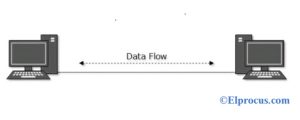
Working
The point-to-point network topology is one of the simplest network topologies in a computer network that provides a direct connection between the two nodes or computers or network devices through a common communication link.
The total bandwidth of the transmission link is reserved only for the point-to-point communication between the two nodes or devices or computers. The actual length of a cable or wire is utilized to provide point-to-Point connections between the nodes. It is also possible to use satellite links or microwaves for connections.
The following diagram illustrates the point-to-Point type in computer networks. It consists of two nodes such as computers or routers or servers or repeaters or any other peripherals connected sequentially using a single communication link or a cable. That means the receiving end of one node is connected to the transmitting end of the other node. When the nodes are connected logically with a point-to-point connection, then they contain several intermediate network devices.
The best example for point-to-point type is, changing TV channels with remote control. The point-to-point connection is established between the remote control and the television’s control network to change the TV channel and ON/OFF the TV.
The data transfer between the nodes in a point-to-point type across the computer network can be in 3 modes such as simplex mode, half-duplex mode, and full-duplex mode.
Simplex Mode
In this mode, the data or signal is transmitted only in one direction. That means, when one node transmits the data, then the other node at the receiving end receives the data. Hence the mode of communication is unidirectional.
Half-Duplex Mode
In this mode, each node on the point-to-point network can receive and transmit the data but not at the same time.
Full-Duplex Mode
In this mode, the data transmission between the nodes is simultaneous. Hence the mode of communication is bidirectional.
This type of network topology in a computer network is very fast, simple, and reliable when compared to other network topologies. It provides a direct connection for fast data transfer between the nodes. But is used for small geographical areas where the nodes or computers are connected very closely.
Hybrid Network Topology
This type of network topology in computer networks is formed by the combination of two or more different types. It is very reliable, flexible, can be modified according to the application, and can handle a large number of nodes and devices. It is very difficult to install due to its complex design. For example, bus topology and star topology can be combined to form the hybrid topology.
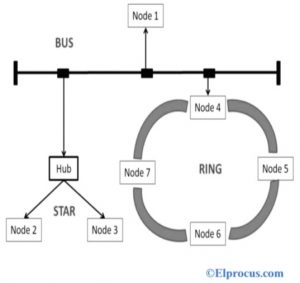
Working
The network topology that combines one or more different topology structures is known as the Hybrid type. It is utilized to transfer the data by providing connections between various network links and nodes.
These types of network topologies are used in larger organizations and companies to transfer their data effectively. The structure of the hybrid type contains two or more different network topologies as shown in the figure below. It shows the combination of star, bus, and ring network topologies.
Example: Internet.
The different network topologies are interconnected by utilizing their features to form an efficient hybrid network topology.
The tree network topology is also referred to as a hybrid network because it is a combination of star and bus network topologies. Based on the requirements of the company, the two or more different network topologies are combined to form a hybrid topology.
The features of the hybrid network include,
- More reliable
- Flexible
- Scalable
- Complex configuration
- It is a combination of the advantages and disadvantages of various network topologies.
Multi-access Type
It is also called NBMA (Non-Broadcast Multiple Access Network) because it consists of multiple hosts linked to transfer the data from one node/computer to another single host over a switched fabric or virtual circuit directly.
Smart Grid Type
In this type, the network configurations are required to facilitate the operations and functions of the system in a smart grid. It is generally an electrical network topology with various smart meters, and efficient energy resources, which are used to control the distribution and production of electricity.
Edge Computing Type
This type of network topology comes under the decentralized computing type that is used to conduct at or nearby of generated data of remote sources, reduce the time travel from client to server, and insight time. It consists of a cloud center or data center, which can connect to gateway edge nodes or edge servers and then be connected to the sensors and loT control devices like connected wind turbines and oil platforms.
Which Network Topology Requires a Central Controller Or Hub?
The star and tree types require a central controller or hub. While ring, mesh, point-to-Point, and bus network topologies don’t require any hub. Every network device or node is connected to a central controller (central node) called hub or router, or switch in a star type. Here the hub or switch acts as a server and all the network components connected to it acts as clients.
It is one of the most widely used network topologies in offices and homes. It is designed with one central node, which acts as a channel or medium to transfer the data. In this type of topology in computer networks, all the nodes or computers and network peripherals are connected to a central controller and represented in the form of a star. This central node acts as a common connection point for all the devices and nodes connected to it and is also called a hub.
All the nodes and devices are connected to a central hub that is configured using twisted cables, fiber optic cables, and coaxial cables to provide a point-to-point connection. The data is transmitted to all the connected hosts or destinations through the central node / central hub / central controller. The central hub acts as a server or repeater and it ensures minimal loss of data transmission.
This type is very easy to modify and install by adding or removing the network devices to the central hub. The network’s performance depends on the efficiency of the central controller, configuration, and power. All the nodes connected to the central hub would disable if any fault in the hub occurs. It is very easy to detect faults and troubleshoot when compared to other network topologies.
The network topology diagram is the visual representation of communication devices like nodes, network devices, connections between the nodes, and transmission links between the network nodes or computers. It shows the path of data transfer between the nodes and shows the arrangement of all the network devices that are interconnected to each other to communicate in a computer network.
This diagram illustrates the three layers of the OSI (Open System Interconnection) reference model such as a physical layer, data link layer, and network layer, which are combined to form a media layer.
The structure and design of network topology are based on the requirements and functionality of the network. A software-generated type diagram represents both physical and logical layouts of the network topology visually. It allows the admins to observe the connections between the nodes and monitor the performance while troubleshooting.
This diagram can be created to illustrate the infrastructure of the network visually. For example, the Network Topology Mapper software tool is one of the best tools to create diagrams.
Advantages and Disadvantages
A network topology in a computer network describes how nodes and network components are interconnected to communicate with each other. It shows the logical and physical arrangement of the nodes/computers and other network peripherals on the network.
The advantages and disadvantages of various types of network topologies in a computer network are discussed below.
The advantages of the point-to-point network topology are,
- Due to the direct connection between the nodes/computers, it is very fast and more reliable than other network topologies.
- It doesn’t require any network operating system
- The individual nodes/computers can access the files easily. So that there is no need to use costly servers.
- Each user can set their permissions to avoid assistance from technicians.
The following are the disadvantages of the point-to-point type.
- The main disadvantage is, it is used only when the computers are connected nearby in small geographical areas.
- The backup of files and folders is not possible.
- No security and permission issues for users to log onto their workstations.
A few of the advantages of the bus network topology are,
- It is easy to design, install and use
- The fault in any one of the nodes doesn’t affect the other nodes and that node can be removed very easily
- It is widely used in small networks i. e., LAN
- The cost of the cable is less
- It is a passive type and the node on the bus is responsible only for transmitting the data but not to move the data from one node to another node.
The following are the disadvantages of the bus network network
- The limited number of nodes and network components are connected because the length of the cable is limited.
- The increase in connected network devices on the bus decreases its efficiency.
- It is applicable only for low-traffic networks.
- Detection of faults is difficult.
- The fault in the backbone cable or bus, the entire network fails.
- Security issues when the data is transmitted to all the nodes.
- The performance is slow when compared to other network topologies.
The advantages of the ring network topology are as follows
- Minimizes data packet collision because the data flow in a circular direction
- It is unidirectional and works as high speed
- Even though the nodes on the network increase, it gives better performance than bus type
- It can handle a large number of nodes with heavy traffic on the network
- The maintenance and troubleshooting of faults is easy
- It is used in long-distance communications without any network server to control the data flow
- The cost is less when compared to other topologies
The following are the disadvantages of ring-type in a computer network
- If the network cable breaks or fails, then it affects the performance of the entire network and might breakdown
- The data should move through all the network nodes because it is a unidirectional ring network topology
- Adding and removing the node is difficult
- It is slower than an Ethernet network.
The advantages of star network topology are given below
- The separate cable is used for each node that can be maintained and manage the entire network very easily
- Easy to identify the faults in the cable and expand the network without disturbing the whole network.
- The central hub or central controller made the management and control of the network very simple
- Easy to remove the faulty node and add the new node
- The data transmission speed is very high
The disadvantages of the star network topology are given below.
- The performance of the whole network depends on the Central hub
- If the central hub fails to receive and send the data to the corresponding node, then the whole network crashes.
- It requires more cabling and wiring when compared to bus and ring network topologies.
The advantages of mesh network topology are given below.
- No network traffic issues due to the dedicated point-to-point connection between the nodes.
- It has multiple communication links for data transfer. If anyone’s path is blocked, then the other path can be accessed for data transfer.
- Easy to identify faults and troubleshoot them.
- No security and privacy issues.
The disadvantages of the mesh type are given below.
- More cabling and input-output ports are needed for the data transmission.
- Difficult to install
- Very costly.
The advantages of tree network topology are given below.
- It is formed by the combination of star and bus
- High scalability due to the hierarchical model.
- The faulty node doesn’t affect the other nodes connected to the tree network
- Maintenance and fault detection is easy
- Provides point-to-point links for individual segments.
The disadvantages of the tree network topology in a computer network are,
- Requires large cabling
- If the central device or central hub fails, then the whole network breaks down.
- Complex network configuration.
The advantages of the hybrid network topology in a computer network are,
- It includes the advantages of combined different network topologies, which forms a hybrid network
- Easy to modify the configuration as per the company’s requirements.
- More flexible
- More reliable
- Scalability is easy
The disadvantages of the hybrid type in a computer network are,
- Very costly due to its complex design
- The change in hardware because one type of network topology is connected to another type of network topology
Thus, this is all about an overview of Network Topology – definition, Topology in a Computer Network, Diagram, Types like Bus, Point-to-Point, Star, Mesh, Tree, Ring, Advantages and Disadvantages. This topology aims to configure the telecommunication networks, which includes control and command radio networks, computer networks, and industrial field buses. Here is a question for you, “What are the differences between the various types of Network Topologies in a Computer Network? “















![Toni Kroos là ai? [ sự thật về tiểu sử đầy đủ Toni Kroos ]](https://evbn.org/wp-content/uploads/New-Project-6635-1671934592.jpg)


